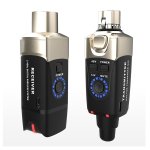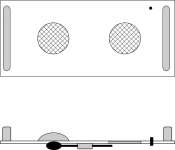Rosie C
Well-known member
I've been umm-ing and aah-ing over microphones for my accordion for weeks now. Let me run this idea past you 
Within our Morris band a mandolin plays the melody, my most important contribution is the harmony chords and bass line (I even wrote an essay for for my uni. course on this!) But while I can amplify the treble side using a vocal mic on a mic stand, I can't do that with the bass as it moves with the bellows.
I can't afford the £890 my local pro wants for a quality mic installation - and I am averse to drilling holes for volume and jack sockets anyway. But I had an idea last night - if I buy some aluminium plate I could make a new bass cover and fit a bass microphone and XLR socket to it - all completely reversible by replacing the original bass cover. I could add treble mics later if I need - feeding the wires through the bellows in the reverse direction to most mic systems. But for now I'll just do bass I think. I already have some T.bone miniature mics to experiment with. I can use a cable for now, but later I can splurge on a pair of Xvive wireless XLR dongles with built-in phantom power.
Within our Morris band a mandolin plays the melody, my most important contribution is the harmony chords and bass line (I even wrote an essay for for my uni. course on this!) But while I can amplify the treble side using a vocal mic on a mic stand, I can't do that with the bass as it moves with the bellows.
I can't afford the £890 my local pro wants for a quality mic installation - and I am averse to drilling holes for volume and jack sockets anyway. But I had an idea last night - if I buy some aluminium plate I could make a new bass cover and fit a bass microphone and XLR socket to it - all completely reversible by replacing the original bass cover. I could add treble mics later if I need - feeding the wires through the bellows in the reverse direction to most mic systems. But for now I'll just do bass I think. I already have some T.bone miniature mics to experiment with. I can use a cable for now, but later I can splurge on a pair of Xvive wireless XLR dongles with built-in phantom power.




